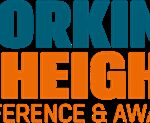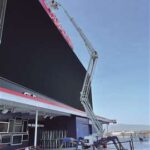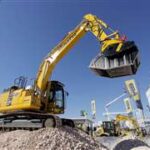Aerial work platforms (AWPs) have become an essential part of the modern industrial and construction landscape. These versatile machines are designed to provide safe, efficient, and accessible solutions for tasks that require working at heights. Whether you’re cleaning windows in a skyscraper, fixing streetlights, or working on power lines, AWPs offer an unmatched level of safety and convenience. Over the years, their applications have expanded far beyond what was initially imagined, and they are now indispensable in a wide variety of industries.
What Makes an Aerial Work Platform Different?
At first glance, an aerial work platform might seem like a simple machine, but these devices are far more than just platforms with a lift. An AWP is a mechanized device that lifts workers, tools, and equipment to heights that would otherwise be dangerous or impractical to reach using traditional methods like ladders or scaffolding. These platforms are used in many fields, including construction, maintenance, telecommunications, and even entertainment.
-
Boom Lifts: The Classic Cherry Picker
One of the most well-known types of AWPs is the boom lift, often referred to as a “cherry picker” because of its origins in fruit picking. While the name suggests a simple tool for harvesting cherries, these lifts have evolved to become one of the most flexible types of AWPs. Boom lifts are equipped with an extendable arm, often articulated (jointed), that allows the operator to reach a variety of difficult or awkward positions. Their ability to move vertically and horizontally, combined with their extendable boom, makes them ideal for tasks that require precise positioning.Today, cherry pickers are used in a wide range of industries. From construction and maintenance to tree care and high-access painting, the boom lift has become a go-to solution for jobs that involve working at height. These platforms can be fitted with additional tools, like hydraulic lifts for carrying heavy materials, or even platforms specifically designed for handling large pieces of glass for window installation.
-
Scissor Lifts: Stability and Vertical Reach
Unlike boom lifts, which are designed to provide a combination of vertical and horizontal reach, scissor lifts are specifically designed for vertical movement. The platform is raised and lowered using a crisscrossing pattern of linked supports, known as a pantograph, which allows for a stable and secure lift. While the vertical-only movement of scissor lifts may seem limiting, this mechanism provides several benefits. It allows for smooth, efficient movement and can lift heavier loads compared to some boom lifts, making it an ideal choice for tasks like maintenance on tall buildings, electrical repairs, or material handling in warehouses.Scissor lifts are often favored for indoor use, especially in areas with tight spaces. Their compact size and ability to be operated in confined environments make them the perfect choice for working in smaller rooms, tight hallways, or places where horizontal movement is unnecessary.
The Rising Demand for AWPs in Various Sectors
The use of AWPs has exploded in recent years, driven by the need for safer, more efficient solutions to working at height. Today, you can find AWPs being used across a broad spectrum of industries and tasks, including emergency services, telecommunications, construction, and even the film industry. The rise in demand is largely due to their flexibility, mobility, and safety features.
-
Construction and Maintenance
In construction, AWPs have become indispensable for tasks like installing or repairing roofs, windows, and facades. For workers on a construction site, having a reliable AWP can mean the difference between completing a project on time or experiencing delays due to safety concerns or inefficiencies. AWPs allow workers to quickly access heights with precision, reducing the time needed to set up scaffolding and minimizing the risk of accidents associated with traditional methods.For maintenance tasks, such as repairing streetlights, working on power lines, or cleaning building exteriors, AWPs provide a safer and more effective solution than ladders or scaffolding. The ability to transport tools and materials up to the work area is another key advantage, making the job faster and reducing the risk of injury from repetitive climbing.
-
Emergency Services
In the world of emergency services, AWPs play a critical role in saving lives. Firefighters, for instance, rely on specialized aerial platforms to gain access to buildings during a fire. These platforms, often equipped with fire hoses and water cannons, allow firefighters to reach high windows or rooftops and rescue people in emergency situations. Furthermore, the mobility of vehicle-mounted AWPs ensures that emergency responders can quickly access and stabilize their position in difficult terrain, such as high-rise buildings or steep roads.Beyond firefighting, AWPs are also essential in rescue operations, particularly in areas where terrain makes it difficult to reach people or places. Emergency responders can use these platforms to access high-risk areas, such as the tops of cliffs or within deep pits, ensuring that they can provide aid when it’s needed most.
-
Telecommunications and Utilities
The telecommunications industry heavily relies on AWPs for maintaining and installing communication lines, such as telephone wires and fiber-optic cables. AWPs allow workers to access power poles, antennas, or other high structures with ease, ensuring that cables can be repaired or installed in a safe, efficient manner. Similarly, utility workers use AWPs to access power lines or conduct inspections on electrical towers, ensuring that they can perform critical work without the risk of falling or dealing with complicated scaffolding setups.
Technology and Safety Features: Evolving for a Safer Future
As technology advances, so too does the sophistication of AWPs. Manufacturers are constantly improving these devices to increase safety, mobility, and efficiency. For example, many AWPs now feature enhanced stability controls, automatic leveling systems, and smart sensors that detect when the platform is unbalanced or overloaded. These systems can automatically adjust the platform to ensure maximum safety, preventing accidents from occurring due to unstable conditions.
Moreover, with the rise of eco-consciousness in the workplace, more and more electric-powered and hybrid-powered AWPs are hitting the market. These machines are not only quieter and more environmentally friendly, but they also allow operators to work indoors without worrying about emissions, making them perfect for indoor projects in places like airports, malls, and hospitals.
-
Remote Control and Enhanced Monitoring
Some newer AWP models are now equipped with remote control systems that allow the operator to control the platform from a distance, providing additional safety in dangerous or high-risk environments. This technology is especially useful for tasks like powerline maintenance or fire-fighting operations, where workers may need to operate the platform without being directly on the machine.Additionally, many AWPs are now equipped with monitoring systems that track the machine’s performance, such as fuel usage, operational hours, and maintenance schedules. This data can help operators manage the equipment more efficiently, improving uptime and ensuring that safety inspections and repairs are performed regularly.
The Future of AWPs: Embracing New Technologies
Looking ahead, the future of AWPs is bright, with continuous innovation driving improvements in safety, efficiency, and versatility. As demand for these platforms grows, so does the need for smarter, more eco-friendly solutions. From electric-powered models to the integration of AI for predictive maintenance, AWPs will continue to evolve in ways that enhance productivity and safety on job sites worldwide.
The next generation of AWPs promises to be smarter, more automated, and increasingly sustainable. By combining cutting-edge technology with versatile design, AWPs are set to become even more indispensable for industries that rely on working at height, ensuring that they remain at the forefront of safety and efficiency in the workplace.




